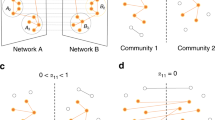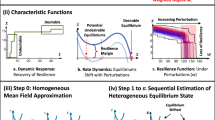Abstract
Recent studies show that in interdependent networks a very small failure in one network may lead to catastrophic consequences. Above a critical fraction of interdependent nodes, even a single node failure can invoke cascading failures that may abruptly fragment the system, whereas below this critical dependency a failure of a few nodes leads only to a small amount of damage to the system. So far, research has focused on interdependent random networks without space limitations. However, many real systems, such as power grids and the Internet, are not random but are spatially embedded. Here we analytically and numerically study the stability of interdependent spatially embedded networks modelled as lattice networks. Surprisingly, we find that in lattice systems, in contrast to non-embedded systems, there is no critical dependency and any small fraction of interdependent nodes leads to an abrupt collapse. We show that this extreme vulnerability of very weakly coupled lattices is a consequence of the critical exponent describing the percolation transition of a single lattice.
This is a preview of subscription content, access via your institution
Access options
Subscribe to this journal
Receive 12 print issues and online access
$209.00 per year
only $17.42 per issue
Buy this article
- Purchase on Springer Link
- Instant access to full article PDF
Prices may be subject to local taxes which are calculated during checkout





Similar content being viewed by others
References
Rosato, V. et al. Modeling interdependent infrastructures using interacting dynamical models. Int. J. Crit. Infrastruct. 4, 63–79 (2008).
Peerenboom, J. P., Fischer, R. E. & Whitfield, R. in Proc. 40th Ann. Hawaii Int. Conf. Syst. Sci. 112–119 (2007); available at http://ieeexplore.ieee.org/xpl/articleDetails.jsp?arnumber=4076595.
Rinaldi, S., Peerenboom, J. & Kelly, T. Identifying, understanding, and analyzing critical infrastructure interdependencies. IEEE Control. Syst. Magn. 21, 11–25 (2001).
Cohen, R. & Havlin, S. Complex Networks: Structure, Robustness and Function (Cambridge Univ. Press, 2010).
Buldyrev, S. V., Parshani, R., Paul, G., Stanley, H. E. & Havlin, S. Catastrophic cascade of failures in interdependent networks. Nature 464, 1025–1028 (2010).
Parshani, R., Buldyrev, S. V. & Havlin, S. Interdependent networks: Reducing the coupling strength leads to a change from a first to second order percolation transition. Phys. Rev. Lett. 105, 048701 (2010).
Vespignani, A. The fragility of interdependency. Nature 464, 984–985 (2010).
Gao, J., Buldyrev, S. V., Havlin, S. & Stanley, H. E. Robustness of a network of networks. Phys. Rev. Lett. 107, 195701 (2011).
Leicht, E. A. & D’Souza, R. M. Percolation on interacting networks. Preprint at http://arxiv.org/abs/0907.0894 (2009).
Brummitt, C. D., D’Souza, R. M. & Leicht, E. A. Suppressing cascades of load in interdependent networks. Proc. Natl Acad. Sci. USA 109, 680–689 (2012).
Hao, J., Cai, S., He, Q. & Liu, Z. The interaction between multiplex community networks. Chaos 21, 016104 (2011).
Bashan, A., Bartsch, R. P., Kantelhardt, J. W., Havlin, S. & Ivanov, P. Ch. Network physiology reveals relations between network topology and physiological function. Nature Commun. 3, 702 (2012).
Huang, X., Gao, J., Buldyrev, S. V., Havlin, S. & Stanley, H. E. Robustness of interdependent networks under targeted attack. Phys. Rev. E (R) 83, 065101 (2011).
Buldyrev, S. V., Shere, N. W. & Cwilich, G. A. Interdependent networks with identical degrees of mutually dependent nodes. Phys. Rev. E 83, 016112 (2011).
Hu, Y., Ksherim, B., Cohen, R. & Havlin, S. Percolation in interdependent and interconnected networks: Abrupt change from second to first order transition. Phys. Rev. E 84, 066116 (2011).
Parshani, R., Buldyrev, S. V. & Havlin, S. Critical effect of dependency groups on the function of networks. Proc. Natl Acad. Sci. USA 108, 1007–1010 (2011).
Bashan, A., Parshani, R. & Havlin, S. Percolation in networks composed of connectivity and dependency links. Phys. Rev. E 83, 051127 (2011).
Schneider, C. M., Yazdani, N., Araujo, N. A. M., Havlin, S. & Herrmann, H. J. Towards designing robust coupled networks. Sci. Rep. 3, 1969 (2013).
Li, W., Bashan, A., Buldyrev, S. V., Stanley, H. E. & Havlin, S. Cascading failures in interdependent lattice networks: The critical role of the length of dependency links. Phys. Rev. Lett. 108, 228702 (2012).
Gao, J., Buldyrev, S. V., Stanley, H. E. & Havlin, S. Networks formed from interdependent networks. Nature Phys. 8, 40–48 (2012).
Schneider, C. M., Moreira, A. A., Andrade, J. S. Jr., Havlin, S. & Herrmann, H. J. Mitigation of malicious attacks on networks. Proc. Natl Acad. Sci. USA 108, 3838–3841 (2011).
Milo, R. et al. Network motifs: Simple building blocks of complex networks. Science 298, 824–827 (2002).
Alon, U. Biological networks: The tinkerer as an engineer. Science 301, 1866 (2003).
Khanin, R. & Wit, E. How scale-free are biological networks. J. Comput. Biol. 13, 810–818 (2006).
Cohen, R., Erez, K., Ben-Avraham, D. & Havlin, S. Resilience of the internet to random breakdown. Phys. Rev. Lett. 85, 4626–4628 (2000).
Dorogovtsev, S. N. & Mendes, J. F. F. Evolution of Networks: From Biological Nets to the Internet and WWW (Physics) (Oxford Univ. Press, 2003).
Barthelemy, M. Spatial networks. Phys. Rep. 499, 1–101 (2011).
Bunde, A. & Havlin, S. Fractals and Disordered Systems (Springer, 1991).
Li, D., Kosmidis, K., Bunde, A. & Havlin, S. Dimension of spatially embedded networks. Nature Phys. 7, 481–484 (2011).
Stauffer, D. & Aharony, A. Introduction to Percolation Theory 2nd edn (Taylor & Francis, 2003).
Son, S., Grassberger, P. & Paczuski, M. Percolation transitions are not always sharpened by making networks interdependent. Phys. Rev. Lett. 107, 195702 (2011).
Dobson, I., Carreras, B. A., Lynch, V. E. & Newman, D. E. Complex systems analysis of series of blackouts: Cascading failure, critical points, and self-organization. Chaos 17, 026103 (2007).
Den Nijs, M. P. M. A relation between the temperature exponents of the eight-vertex and q-state Potts model. J. Phys. A 12, 1857–1868 (1979).
Nienhuis, B. Analytical calculation of two leading exponents of the dilute Potts model. J. Phys. A 15, 199–213 (1982).
Acknowledgements
We acknowledge the European EPIWORK and MULTIPLEX (EU-FET project 317532) projects, the Deutsche Forschungsgemeinschaft (DFG), the Israel Science Foundation, ONR and DTRA for financial support.
Author information
Authors and Affiliations
Contributions
A.B., Y.B., S.V.B. and S.H. conceived and designed the research. Y.B. carried out the numerical simulations. A.B. developed the theory and wrote the paper with contributions from all other authors.
Corresponding author
Ethics declarations
Competing interests
The authors declare no competing financial interests.
Supplementary information
Supplementary Information
Supplementary Information (PDF 276 kb)
Rights and permissions
About this article
Cite this article
Bashan, A., Berezin, Y., Buldyrev, S. et al. The extreme vulnerability of interdependent spatially embedded networks. Nature Phys 9, 667–672 (2013). https://doi.org/10.1038/nphys2727
Received:
Accepted:
Published:
Issue Date:
DOI: https://doi.org/10.1038/nphys2727
This article is cited by
-
Robustness and resilience of complex networks
Nature Reviews Physics (2024)
-
Interdependent superconducting networks
Nature Physics (2023)
-
Approximating the Controllability Robustness of Directed Random-graph Networks Against Random Edge-removal Attacks
International Journal of Control, Automation and Systems (2023)
-
Critical behaviors of cascading dynamics on multiplex two-dimensional lattices
Journal of the Korean Physical Society (2023)
-
A tensor-based formulation of hetero-functional graph theory
Scientific Reports (2022)



